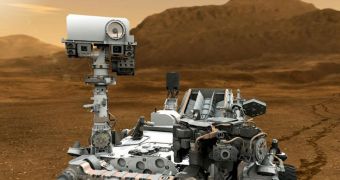Officials at the NASA Jet Propulsion Laboratory (JPL), in Pasadena, California, have just released a new video, depicting how the Mars Science Laboratory (MSL) rover Curiosity will reach and explore the Red Planet.
The video shows the orbital maneuvers that the MSL and its related components will perform when they reach Earth orbit, and how the vehicle will then head for Mars. The clip then jumps 8 and a half months later, when the rover reaches Mars.
It then depicts how the entire aeroshell containing Curiosity enters Martian atmosphere, continuously adjusting its trajectory via built-in thrusters. The entire descent, and the intricate maneuvers related to landing the 1-ton machine on the surface of our neighboring planet are also depicted.
Those interested can also get a view of how the Sky Crane deployment system will work. There are two versions of the video, a longer, 11-minute one, and a shorter, narrated one, which is also embedded at the end of this article.
If all goes well, the MSL will depart for Mars aboard an Atlas V delivery system sometime between November 25 and December 18. If this launch window is missed, the next one will come in about 26 months, experts say.
The new video is “a treat for the 2,000 or more people who have worked on the Mars Science Laboratory during the past eight years to watch these action scenes of the hardware the project has developed and assembled,” says Pete Theisinger.
“The animation also provides an exciting view of this mission for any fan of adventure and exploration,” adds the expert, who is the JPL MSL project manager. He says that the video even features sequences showing the MSL conducting science on Mars.
For added realism, experts also included actual Martian landscapes in the clip. They were reproduced from 3D images of the surface, taken by past and current missions. Datasets from the NASA Mars Reconnaissance Orbiter (MRO) HiRISE camera were heavily used.
JPL manages the Mars Science Laboratory project for the NASA Science Mission Directorate (SMD), in Washington, DC. The rover and other parts of the spacecraft have already been delivered to NASA Kennedy Space Center (KSC) in Florida.
The rover will launch from Space Launch Complex 41 (SLC-41), at the Cape Canaveral Air Force Station (CCAFS). At this point, integration and testing are on track for a launch in late November.
Video Credit: NASA / JPL
 14 DAY TRIAL //
14 DAY TRIAL //